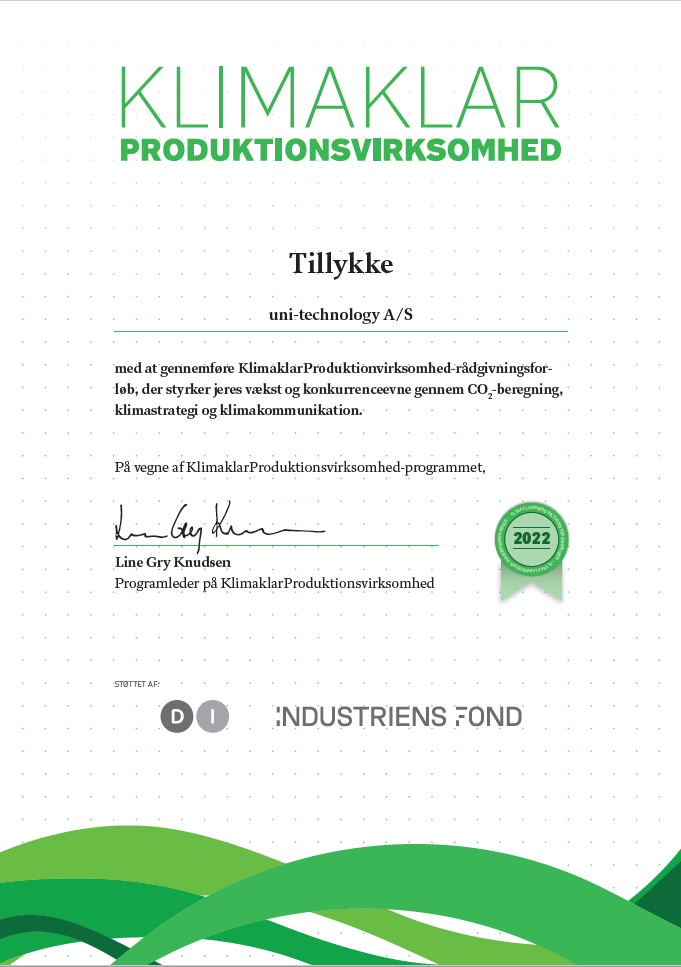Uni-Technology invests in green transition
Tool manufacturer Uni-Technology A/S in Vejle has made an important decision regarding green transition.
The company wants to go “all in” to obtain a certification of its efforts to promote the green transition. The goal has been to be approved in the Science Based Targets initiative (SBTi) to commit to significantly reducing its carbon footprint by 2030.
The first milestone in the project was reached at the beginning of July. Uni-Technology received their diploma for completing Climate-Ready Production Company program.
It is a consultancy program supported by Confederation of Danish Industry and the Danish Industry Foundation .
The result of this process is the first calculation of the company’s CO2 emissions for the base year 2018.

Kenneth Westergaard, Owner, and CEO of Uni-Technology says:
“We’ve been talking for a long time about wanting to make a positive impact on the environment with the way we run our business.
At the same time, we are sure that it is good business. Many customers expect us to have an active environmental strategy, and a few have even started to demand it.
We also believe that we will become a more attractive workplace making it easier to attract new employees.
Finally, it is common sense and good economy to do something about, for example, our energy consumption. It is one of the heavy cost items in our accounts”.
How do you get started with CO2 calculations?
Like many other SMEs, it was difficult for Uni-Technology to get started. They had a good dialogue with the Confederation of Danish Industry about the Climate-Ready Production Company program. However, they did not really know where to start and who should be responsible for the task internally.
Therefore, Uni-Technology decided to assign a project manager to run the project and involve all employees in the process.
At the same time, Uni-Technology was a bit lucky. Together with a handful of other companies, they joined the second wave of Climate-Ready Production Company program in the summer of 2022. And then things started moving fast.
Already at the beginning of July, the CO2 accounts were ready, and work could begin on projects to reduce CO2 emissions.
“Even as we were working on mapping our CO2 -footprint, ideas for CO2-reductions and savings among employees were bubbling. The ideas were collected in a catalogue. After the summer holidays we will start prioritising the projects, calculating saved CO2-emissions and payback time on investments. We want to involve all employees in the project. That way everybody feel ownership of contributing to the green transition”, says Jan Michael Jensen, project manager at Uni-Technology.
Data on CO2 emissions can be found e.g., in purchase invoices
The mapping of CO2 emissions started with the collection of data from a variety of sources. There has been close dialogue with utility companies and other suppliers, and hundreds of purchase invoices have been scrutinized. All purchases have been categorised according to the emission categories found in the Green House Gas Protocol, which is the internationally recognised standard for calculating CO2 emissions.
The actual calculation of CO2 emissions has been done in close collaboration with the consulting company Viegand Maagøe, which specialises in this discipline.
“I had already made the calculation in the Climate Compass, which is the Danish Business Authority’s official tool for calculating CO2 emissions.
However, Viegand Maagøe turned out to have more precise calculation methods for calculating CO2 emissions for several of the products and services we procure from subcontractors.
It has been a great sparring with Viegand Maagøe, which has made the calculation of our CO2 emissions even more accurate. At the same time, it was a good learning process, because none of us in the industry have experience with CO2 calculation”, Jan Michael Jensen continues.
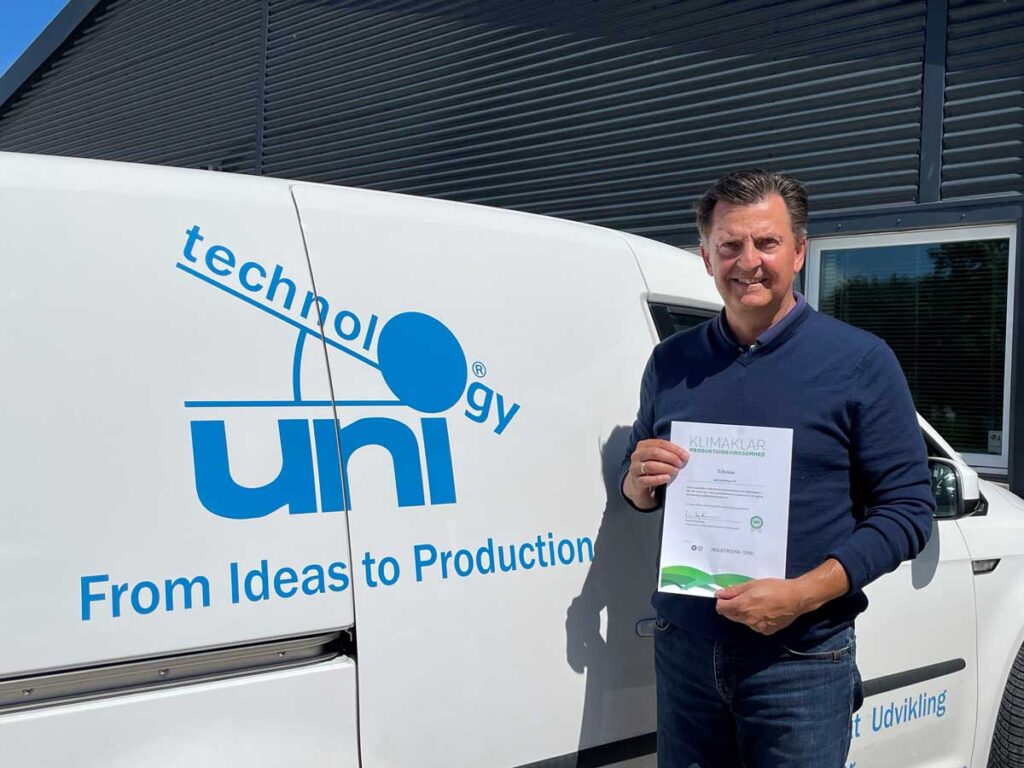
“We are proud to have completed The Climate Ready Production Company”, says Project Manager Jan Michael Jensen, Uni-Technology.
The next step is a mapping of energy consumption
Uni-Technology is now conducting a mapping of energy consumption, so you know where in the company to focus on savings on e.g., electricity. There are machines, cooling systems, ventilation, compressed air systems, lighting and much more that use large amounts of electricity both inside and outside normal working hours.
At the same time, it must be investigated whether investments should be made in, for example, photovoltaic systems, electric cars, or other things to reduce CO2 emissions.
“Back in 2018, we decided to convert all our electricity purchases to 100% green energy from wind turbines, and several years ago we switched from natural gas to district heating, so we have been in the process of transition for a number of years. Now we are taking the next step and starting to work on more projects to reduce our CO2 emissions. The side benefit should be a better working environment and monetary savings, so it’s a win-win”, Kenneth Westergaard concludes.
Science Based Targets initiative (SBTi)
SBTi is a collaboration between the Carbon Disclosure Project, the World Resources Institute, WWF and the UN Global Compact.
The initiative is designed to promote ambitious climate action in the private sector by mobilising companies to set climate reduction targets that are in line with climate research recommendations.
The list of companies that have joined includes Vestas, Novo Nordisk and Grundfos.
Contact us and let us set your idea into production
Sales, development and production
- Thomas Nørmølle
- tn@unitechnology.dk
- +45 53 85 07 27
- Kim Meyer
- km@unitechnology.dk
- +45 28 96 18 33
Climate-ready Production Company
Latest cases og news
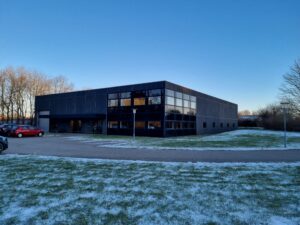
Uni-Technology A/S acquires the activities of Stensved Formværktøj ApS
Press release The Vejle based tool manufacturer Uni-Technology A/S has through the newly established subsidiary
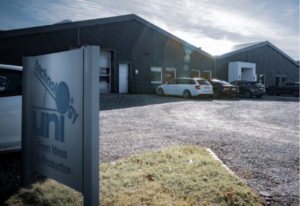
2023 will be another good year for Uni-Technology
2022 was a great and busy year, where we despite various crises at home and
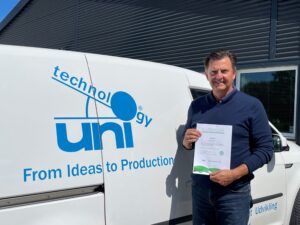
Green is the new black
Case story from DI Business 10 November 2022 In early summer 2022, Uni-Technology A/S in
